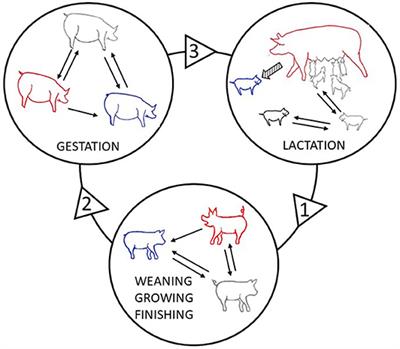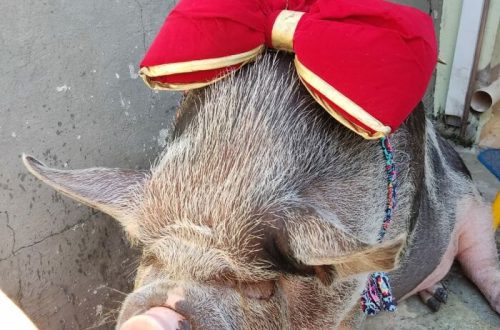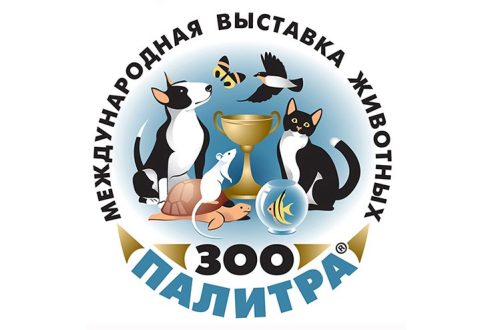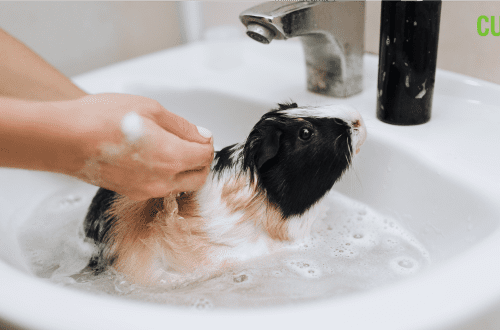
Integrating gilts into a kin group
Translator’s Preface
What is the main task of the breeder? Of course, this is a concern that his offspring fall into good hands. What are “good hands”? “Good hands” is the owner who provides the correct maintenance, in which the living conditions of the animal are as close as possible to the living conditions of animals in nature. Only in such conditions will the pig be happy. These conditions include the fact that in nature pigs live in groups and you need to keep at least two pigs in a cage. Pigs communicate with each other in a language they understand, perform sniffing rituals, etc. A person cannot replace all this with himself. The main mistake is people’s belief that if they take a pig to bed, stroke it, sing songs to it, etc., then the pig will be happy.
Translator’s Preface
What is the main task of the breeder? Of course, this is a concern that his offspring fall into good hands. What are “good hands”? “Good hands” is the owner who provides the correct maintenance, in which the living conditions of the animal are as close as possible to the living conditions of animals in nature. Only in such conditions will the pig be happy. These conditions include the fact that in nature pigs live in groups and you need to keep at least two pigs in a cage. Pigs communicate with each other in a language they understand, perform sniffing rituals, etc. A person cannot replace all this with himself. The main mistake is people’s belief that if they take a pig to bed, stroke it, sing songs to it, etc., then the pig will be happy.
Contents
Integration of pigs into a group of relatives.
What should be paid attention to?
Very often, breeders and hobbyists are faced with the question of integrating gilts into a group. Such questions may arise, for example, in the event of the death of one pig and the purchase of a new partner for the remaining one, or when the breeder wants to expand his group, etc.
How should groups be formed to avoid friction and conflict?
In nature, pigs live in groups: one male and several females with their offspring. A harem can contain up to 15 females. When the offspring grows up, young males try to recapture a couple of females from the leader for themselves and organize their own harem. Juveniles rarely succeed, so young males live in groups of males until they have conquered their females. Some males remain forever in such a group and behave like pseudo-females. Some males remain in the harem in which they were born. In such cases, they are much lower in rank than the leader, but they also manage to participate in breeding when the leader “gaps” and does not notice their mating with the female.
Domestic guinea pigs have the same needs as their wild counterparts. These needs include, along with food and sufficient space, the presence of at least one relative nearby. Pigs are born in a group, grow up in it, receive a certain rank. The group communicates in their own language, group members recognize each other by smell. Daily sniffing is a necessary ritual. Under the roof of a man, pigs should not be deprived of these opportunities. But integrating gilts into a group is not always an easy process…
What should be paid attention to?
Very often, breeders and hobbyists are faced with the question of integrating gilts into a group. Such questions may arise, for example, in the event of the death of one pig and the purchase of a new partner for the remaining one, or when the breeder wants to expand his group, etc.
How should groups be formed to avoid friction and conflict?
In nature, pigs live in groups: one male and several females with their offspring. A harem can contain up to 15 females. When the offspring grows up, young males try to recapture a couple of females from the leader for themselves and organize their own harem. Juveniles rarely succeed, so young males live in groups of males until they have conquered their females. Some males remain forever in such a group and behave like pseudo-females. Some males remain in the harem in which they were born. In such cases, they are much lower in rank than the leader, but they also manage to participate in breeding when the leader “gaps” and does not notice their mating with the female.
Domestic guinea pigs have the same needs as their wild counterparts. These needs include, along with food and sufficient space, the presence of at least one relative nearby. Pigs are born in a group, grow up in it, receive a certain rank. The group communicates in their own language, group members recognize each other by smell. Daily sniffing is a necessary ritual. Under the roof of a man, pigs should not be deprived of these opportunities. But integrating gilts into a group is not always an easy process…
The first meeting
If you put two unfamiliar pigs together, a ritual of acquaintance and determination of rank inevitably occurs between them: sniffing and trying to jump on each other are completely normal. Animals can chatter their teeth and jump on each other. Do not interfere with them while doing this (unless they are fighting seriously). Acquaintance requires patience from the breeder. The determination of the rank lasts, as a rule, several days, after all, the pigs are quite peaceful animals. If the mumps will be persecuted by relatives after a few days, it must be separated from the group.
Since pigs also have their own character and dislikes, before buying a new piglet, it is recommended to take a closer look at whether it will fit into your group. A very useful thing: before you put a new pig in a group, you need to rub its back with dirty sawdust from the cage in which you are going to plant it. Such a pig is often perceived as one’s own. Also helps the first acquaintance in neutral territory. At this time, the cage must be washed and a slight rearrangement of houses and other accessories should be made in it. In the cage, there must be houses for each of the pigs, and at first the food must be scattered throughout the cage in order to avoid friction at the feeder.
If you put two unfamiliar pigs together, a ritual of acquaintance and determination of rank inevitably occurs between them: sniffing and trying to jump on each other are completely normal. Animals can chatter their teeth and jump on each other. Do not interfere with them while doing this (unless they are fighting seriously). Acquaintance requires patience from the breeder. The determination of the rank lasts, as a rule, several days, after all, the pigs are quite peaceful animals. If the mumps will be persecuted by relatives after a few days, it must be separated from the group.
Since pigs also have their own character and dislikes, before buying a new piglet, it is recommended to take a closer look at whether it will fit into your group. A very useful thing: before you put a new pig in a group, you need to rub its back with dirty sawdust from the cage in which you are going to plant it. Such a pig is often perceived as one’s own. Also helps the first acquaintance in neutral territory. At this time, the cage must be washed and a slight rearrangement of houses and other accessories should be made in it. In the cage, there must be houses for each of the pigs, and at first the food must be scattered throughout the cage in order to avoid friction at the feeder.
Different patterns of gender groups
In principle, there are many models for integrating gilts into a group. For beginner breeders, keeping two pigs in one cage is enough.
If one of the pigs dies, it must be replaced with a new one. Breeders recommend taking a new pig about the same age as the remaining one. Young pigs are too playful and will often get on the nerves of pigs at a respectable age, and in turn the young pig will lack a playmate. A group of four pigs is much better than a group of three, as it is not uncommon for two-against-one plots to occur in a group of three.
There are different groups of guinea pigs based on gender:
- group of females
- a group of females with a castrated male;
- group of males.
- a group of females with a male (if there are no problems with the placement of offspring, then you can keep real harems of guinea pigs).
group of males The content of the group of males causes the greatest discussion. The content of such a group is very possible. There are several rules: females must be removed from the olfactory area of the group. A clear distribution of ranks leads to a peaceful way of life. Adult males behave towards male piglets in the same way as towards females. Piglets raised with a male leader, as a rule, do not cause problems with further integration into a group of males. Only the integration of two leaders should be avoided. They get along very well, for example, father with piglets, brothers.
group of females Rank friction between females very rarely ends in wounds and injuries, but nevertheless, there are females who defend their territory to the last. In such cases, integration is obtained only from the second or third time. The closer the animals are in rank to each other, the more difficult the integration. The opinion that all pigs in a group are equal is misleading. Each has its own place in the group, sometimes there are frictions, but they are completely normal. There is no reason to think that the group is not functioning. It is not a problem to place young females in a group, since they initially know their place due to their age and do not resist older females. The elders will sniff them, give them a little drive for decency, and that will be the end of it. When integrating adult females, conflicts may arise until their rank in the group is finally determined.
A group of females with a castrated male This is undoubtedly the most harmonious combination. The male must be castrated no earlier than nine months old so that he can later gain authority in the group. The castrato restores order in case of quarrels between females.
© Petra Hemeinhardt
© Translated by Larisa Schulz
*Translator’s note: I keep a group of four males and one group of two females. Let me add from my own observations: one of the reasons for the quarrels of males is their idleness. One of the keys to success is an inexhaustible supply of hay in a cage, twigs, toys, houses, etc. When the males are bored, they begin to find out whose cones are in the forest. Some members of the forum in our club keep groups of males, some managed to reconcile aggressive females.
Comment on the forum of the MMS Club (participant – Norka):
Great article! Everything is on point! Of course, pigs are always more fun to live with relatives. The exception, as always, happens, it is made up of individual specimens with a quarrelsome character. (People also have these.) For several years now I have been watching the life of my pigs, since our life, one might say, passes side by side (in the kitchen). I’ve also grown a little on swine psychology, so I absolutely agree with every word of the article!
My pig Stas is now sitting alone. (because I don’t want spring offspring, we get it with too “big blood” due to our own immune reserves). Yes, allow me to praise myself once again, I am an excellent owner: in a cage it is always higher than the roof and food, and hay, and other bells and whistles. Stas does not look particularly dull and deprived. Yes, he would happily live alone. But you should have seen his eyes when I take out one of his relatives from the next cage! He reaches for it like a cucumber! Therefore, I affirm that any little animal (except for a rare exception) needs communication! Especially herd and pack animals! Yes, maybe they historically huddled together in packs for better survival in the wild. But they have historically gone astray with all the consequences that come from here! They only have a real life going on in a flock: love, disassembly, communication, joint protection, etc. This is life!
Right now I have a herd of three girls, so the eldest “at the entrance” Nyuska doesn’t eat her “bread” for nothing – she protects the others in case of danger (for example, when the vacuum cleaner is close or the dog sniffs, everyone hides behind her, she moves forward). And before that, Stas defended like that. Yes, there were frictions when I “knocked together” a herd. Endured a week. Now everything is great. Note that I do not call for buying a huge number of animals, keeping them in a cramped cage, feeding them poorly, with the expression “but they will have fun!”. Not at all. This is another extreme.
I urge you to find a middle ground, so that it is not expensive for you, and the little animals live well. Therefore, when buying an animal, of course, you should always tell the future owner that these are herd animals and, if possible, get at least two animals. And when they call me about piglets, I personally always ask if there are more pigs, or if there are more planned, what is the “living space”. And if they tell me that they can only keep one pig in a small cage due to lack of space, and then a person with “normal” conditions calls, then of course I will choose the second one. And the future owner should learn more about the purchased animal and take care of its good future in advance, and not just buy it as another toy for the child, or as a joy for himself, lonely, not understood by anyone. This is not a reason to leave lonely and the animal too.
On my part, as a breeder, I personally always give a discount of almost 50% if two pigs are taken from me at once, since the main thing for me, as a lover, is a happy tomorrow for my animals, so that it would not be excruciatingly painful later. Of course, I assume that the big breeders are a little different. Alas, that’s why they are large breeders. Each has its pros and cons.
I, as a biologist of a new type, as an employee of WWF (I can’t guarantee Greenpeace, but WWF is always on you! 🙂 I dare to say that some “humanization” of an animal is sometimes useful! For it is not an unreasonable creature. they are all different, and tastes, and love, there are all sorts of other relationships (maybe remotely, but too sometimes reminiscent of human).If we treat animals as our own kind, and think about their needs, and know and consider them “nature” (their habits, their relationships in the wild, etc.), and maintain normal, “human” conditions for them, then only the animals will feel good with us.
In principle, there are many models for integrating gilts into a group. For beginner breeders, keeping two pigs in one cage is enough.
If one of the pigs dies, it must be replaced with a new one. Breeders recommend taking a new pig about the same age as the remaining one. Young pigs are too playful and will often get on the nerves of pigs at a respectable age, and in turn the young pig will lack a playmate. A group of four pigs is much better than a group of three, as it is not uncommon for two-against-one plots to occur in a group of three.
There are different groups of guinea pigs based on gender:
- group of females
- a group of females with a castrated male;
- group of males.
- a group of females with a male (if there are no problems with the placement of offspring, then you can keep real harems of guinea pigs).
group of males The content of the group of males causes the greatest discussion. The content of such a group is very possible. There are several rules: females must be removed from the olfactory area of the group. A clear distribution of ranks leads to a peaceful way of life. Adult males behave towards male piglets in the same way as towards females. Piglets raised with a male leader, as a rule, do not cause problems with further integration into a group of males. Only the integration of two leaders should be avoided. They get along very well, for example, father with piglets, brothers.
group of females Rank friction between females very rarely ends in wounds and injuries, but nevertheless, there are females who defend their territory to the last. In such cases, integration is obtained only from the second or third time. The closer the animals are in rank to each other, the more difficult the integration. The opinion that all pigs in a group are equal is misleading. Each has its own place in the group, sometimes there are frictions, but they are completely normal. There is no reason to think that the group is not functioning. It is not a problem to place young females in a group, since they initially know their place due to their age and do not resist older females. The elders will sniff them, give them a little drive for decency, and that will be the end of it. When integrating adult females, conflicts may arise until their rank in the group is finally determined.
A group of females with a castrated male This is undoubtedly the most harmonious combination. The male must be castrated no earlier than nine months old so that he can later gain authority in the group. The castrato restores order in case of quarrels between females.
© Petra Hemeinhardt
© Translated by Larisa Schulz
*Translator’s note: I keep a group of four males and one group of two females. Let me add from my own observations: one of the reasons for the quarrels of males is their idleness. One of the keys to success is an inexhaustible supply of hay in a cage, twigs, toys, houses, etc. When the males are bored, they begin to find out whose cones are in the forest. Some members of the forum in our club keep groups of males, some managed to reconcile aggressive females.
Comment on the forum of the MMS Club (participant – Norka):
Great article! Everything is on point! Of course, pigs are always more fun to live with relatives. The exception, as always, happens, it is made up of individual specimens with a quarrelsome character. (People also have these.) For several years now I have been watching the life of my pigs, since our life, one might say, passes side by side (in the kitchen). I’ve also grown a little on swine psychology, so I absolutely agree with every word of the article!
My pig Stas is now sitting alone. (because I don’t want spring offspring, we get it with too “big blood” due to our own immune reserves). Yes, allow me to praise myself once again, I am an excellent owner: in a cage it is always higher than the roof and food, and hay, and other bells and whistles. Stas does not look particularly dull and deprived. Yes, he would happily live alone. But you should have seen his eyes when I take out one of his relatives from the next cage! He reaches for it like a cucumber! Therefore, I affirm that any little animal (except for a rare exception) needs communication! Especially herd and pack animals! Yes, maybe they historically huddled together in packs for better survival in the wild. But they have historically gone astray with all the consequences that come from here! They only have a real life going on in a flock: love, disassembly, communication, joint protection, etc. This is life!
Right now I have a herd of three girls, so the eldest “at the entrance” Nyuska doesn’t eat her “bread” for nothing – she protects the others in case of danger (for example, when the vacuum cleaner is close or the dog sniffs, everyone hides behind her, she moves forward). And before that, Stas defended like that. Yes, there were frictions when I “knocked together” a herd. Endured a week. Now everything is great. Note that I do not call for buying a huge number of animals, keeping them in a cramped cage, feeding them poorly, with the expression “but they will have fun!”. Not at all. This is another extreme.
I urge you to find a middle ground, so that it is not expensive for you, and the little animals live well. Therefore, when buying an animal, of course, you should always tell the future owner that these are herd animals and, if possible, get at least two animals. And when they call me about piglets, I personally always ask if there are more pigs, or if there are more planned, what is the “living space”. And if they tell me that they can only keep one pig in a small cage due to lack of space, and then a person with “normal” conditions calls, then of course I will choose the second one. And the future owner should learn more about the purchased animal and take care of its good future in advance, and not just buy it as another toy for the child, or as a joy for himself, lonely, not understood by anyone. This is not a reason to leave lonely and the animal too.
On my part, as a breeder, I personally always give a discount of almost 50% if two pigs are taken from me at once, since the main thing for me, as a lover, is a happy tomorrow for my animals, so that it would not be excruciatingly painful later. Of course, I assume that the big breeders are a little different. Alas, that’s why they are large breeders. Each has its pros and cons.
I, as a biologist of a new type, as an employee of WWF (I can’t guarantee Greenpeace, but WWF is always on you! 🙂 I dare to say that some “humanization” of an animal is sometimes useful! For it is not an unreasonable creature. they are all different, and tastes, and love, there are all sorts of other relationships (maybe remotely, but too sometimes reminiscent of human).If we treat animals as our own kind, and think about their needs, and know and consider them “nature” (their habits, their relationships in the wild, etc.), and maintain normal, “human” conditions for them, then only the animals will feel good with us.





